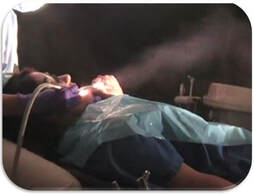 We are all aware that there is a pandemic going on. Everyone has encountered deserted waiting areas, burning through multiple layers of PPE, and intensified disinfection efforts, but there may be some good news. We can see this as a chance to modernize our infection prevention measures, which is crucial for our patients, ourselves, and our families. You now have your doctor's attention; therefore, there is no time like the present. This pandemic is forcing us to alter our practices, much like the HIV/AIDS crisis did in the 1980s. Both the modifications we made at the time and the current modifications are required advancements. Previously, treating a patient without gloves was permissible, but today, that is the accepted standard of care. Pre-rinsing has always been advised but is only recently being acknowledged as an essential step in infection management, similar to the wearing of gloves. It is well known that dental aerosols are dangerous. Pre-rinsing, however, kills the bacteria before they become aerosolized, in contrast to the majority of our present PPE, which is made to act as a barrier between us and particles. Is this effective? Let's turn to science; a recent study found that pre-procedural rinse significantly reduces the germs in aerosols by 97%. This result was discovered by taping agar plates to the walls of a treatment room during the investigation. The plates were subsequently grown in an incubator following the aerosol exposure. There was 94% less bacterial growth when the patient pre-rinsed before receiving treatment. As a result, there will be less bacteria on the countertops, walls, equipment, air, operator's clothing, and clinician's lungs. This demonstrates that a little pre-rinse can at the very least cut down on the contaminants that are still in the air. Pre-rinsing is a straightforward process, but picking the ideal rinse can be challenging. While viruses are under scrutiny in the contemporary climate, bacteria have historically been the primary concern in dentistry. As a result, several commonly used pre-rinses (such as Listerine and Chlorhexidine) do relatively little to eliminate viruses. Pre-rinses have to be able to eradicate fungus and viruses in addition to bacteria. A good pre-rinse should also have the capacity to kill swiftly, ideally in under a minute. In a typical dental situation, waiting 5 to 10 minutes for your pre-rinse to take effect is not practical. Who has time to wait that long to begin treating their patient? For instance, hydrogen peroxide shows limited virucidal activity until 5 minutes of contact, and effectiveness also seems to decline with a decreased concentration of the active element. Additionally, effectiveness seems to decline with a decreased concentration of the active element. Using commercially available rinses (1.5% and 3.0% H2O2), a research by the American College of Prosthodontists found that these concentrations have limited virucidal action at both 15 and 30 second exposures, which is a normal rinse time. Few compounds rival the oxidizing potency of chlorine dioxide when it comes to destroying bacteria, fungus, and viruses. Chlorine dioxide has been used to aid in disinfection in various industries for close to 200 years, despite its more recent application in dentistry. In contrast to other oxidizers like ozone and peroxide, chlorine dioxide is a very selective oxidizer. What does the term "selective" mean? Ozone and peroxide are stronger oxidants that react with many of the other components of saliva because they are less selective in what they break down. The oxidation potential is exhausted before it has a chance to interact with the target pathogen. Additionally, it interacts with bodily cells, which has a detrimental effect on tissue responsiveness. For this reason, surgeons traditionally avoid using products that include peroxide. Chlorine dioxide is safe and efficient. Even medical equipment and electronic devices utilized in the treatment of patients on the front lines of the fight against Ebola in West Africa were sterilized by the US military using chlorine dioxide. Additionally, it has a history of use and success against the influenza A virus. OraCare is one of the only products that uses activated chlorine dioxide. It has various medical applications, but pre/post rinsing has been its primary use for the past ten years. Furthermore, a recent study validated OraCare's capacity to eradicate human Coronavirus with no cell damage. OraCare can safeguard you as a dental expert in addition to helping your patients' oral health. Learn about your options because there are many, as with anything else. Any pre-rinse is always preferable to doing nothing at all. Just make sure the rinse you select eliminates all the microorganisms without harming your patient.
0 Comments
|
Kristin Goodfellow RDHKristin is Chief Clinical Officer of OraCare, a practicing Registered Dental Hygienist Archives
August 2023
Categories |
1-855-255-6722OraCare is made in the USA.
|
OraCare© COPYRIGHT 2015. ALL RIGHTS RESERVED.

 RSS Feed
RSS Feed